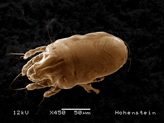No chance for house dust mites

Close-up of a mite:faeces particles reach mucus membranes via the respiratory tracts which can trigger typical symptoms:runny nose, itchy eyes and, in severe cases,even shortness of breath and asthma ® Hohenstein Institute
On average a person spends 8 out of 24 hours asleep. Over a year, this is almost 3000 hours spent in bed, or rather, on a mattress. However, it's not just people who feel comfortable here. Mites ranging in size from 0.1 mm – 0.5 mm also feel at home.
A mattress provides perfect conditions for mites. An average temperature of 25 degrees, humidity of up to 70 percent as well as human skin flakes on which the white arachnids feed. However, as well as in mattresses, mites are also found in bedding, upholstered furniture and carpets.
Between 4 and 5 million Germans suffer from an allergy to house dust mites, which is caused not by the mite itself, but by their faeces.
Stirred up faeces particles reach the individual's mucus membranes via the respiratory tracts and, if the individual is allergic, they trigger typical symptoms including a runny nose, streaming or itchy eyes and, in severe cases, even asthma and shortness of breath.
The Hohenstein scientists from the department for Hygiene, Environment & Medicine are testing the efficiency of textiles in reducing house dust mites and mite allergens or providing an effective barrier against them.
Tests are therefore being carried out at the Hohenstein Institute on the impermeability of bedding and encasings against mite faeces. Encasings are special mattress covers which are used to avoid contact with allergens. Scientific studies have shown that they offer relief from house dust mite allergies.
The challenge for the manufacturers is to design the casings in such a way that they form a physical barrier created from the fabric structure and the laminate network. This must also be sufficiently resistant to mite faeces when the sleeping person turns over during the night. The special feature of the encasing test carried out by the Hohenstein Institute is that real mite faeces from house dust mites are used.
Surfaces, seams, and zip fasteners are applied with real mite faeces and the strain during sleep is reconstructed through pressure and friction. The quantity of mite faeces allergens which manage to get through the material during the simulated use is measured (“Der p1”). The value for this test must not exceed two micrograms (corresponds to the sensitization threshold for persons allergic to house dust mites).
The test for resistance (barrier effect) against mite faeces allergens is a DAkkS-accredited service and will be carried out exclusively by the Hohenstein Institute across Germany using real mite faeces.
To help persons with allergies to make their decisions, tested materials are awarded the Hohenstein quality label “House Dust and Mite Barrier”. This is particularly interesting for the health service and the hotel and hospitality industry as the quality label gives a reliable signal to customers and guests. In addition, complaints can be effectively minimised with the test and safety for consumers increased.
A further DAkkS-accredited test by the Hohenstein Institute is the examination of the long-term impact of textiles and chemicals that should restrict the development of house dust mites. This long-term test is carried out in accordance with standard NF G39-011. House dust mites are applied to the test samples and controls. After two population cycles, i.e. 6 weeks, under optimum conditions for the mites, the number of living mites is either counted directly using a stereo microscope or, in the case of three-dimensional test samples, the allergen content (“Der p1”) is determined.
Products that are very effective at preventing the growth of the mite population receive the certificate “Anti Dust Mite”. On demand it can also be awarded the quality label “Anti Dust Mite”. The customer can thus easily see that he is purchasing a product suitable for persons allergic to house dust mites – a key purchasing decision.
Both quality labels presented here, “House Dust and Mite Barrier” and “Anti Dust Mite”, can be easily combined with other quality labels from the Hohenstein Institute, for example, the “Sleep Comfort Vote” or “Hypoallergenic”.
Contact person for anti-mite tests:
Hygiene, Environment and Medicine
Team Bioservice
Tel: +49 7143 271 444
Fax: +49 7143 271 94444
E-mail: bioservice@hohenstein.de
Homepage: www.hohenstein.de
Media Contact
All latest news from the category: Life Sciences and Chemistry
Articles and reports from the Life Sciences and chemistry area deal with applied and basic research into modern biology, chemistry and human medicine.
Valuable information can be found on a range of life sciences fields including bacteriology, biochemistry, bionics, bioinformatics, biophysics, biotechnology, genetics, geobotany, human biology, marine biology, microbiology, molecular biology, cellular biology, zoology, bioinorganic chemistry, microchemistry and environmental chemistry.
Newest articles

First-of-its-kind study uses remote sensing to monitor plastic debris in rivers and lakes
Remote sensing creates a cost-effective solution to monitoring plastic pollution. A first-of-its-kind study from researchers at the University of Minnesota Twin Cities shows how remote sensing can help monitor and…

Laser-based artificial neuron mimics nerve cell functions at lightning speed
With a processing speed a billion times faster than nature, chip-based laser neuron could help advance AI tasks such as pattern recognition and sequence prediction. Researchers have developed a laser-based…

Optimising the processing of plastic waste
Just one look in the yellow bin reveals a colourful jumble of different types of plastic. However, the purer and more uniform plastic waste is, the easier it is to…



